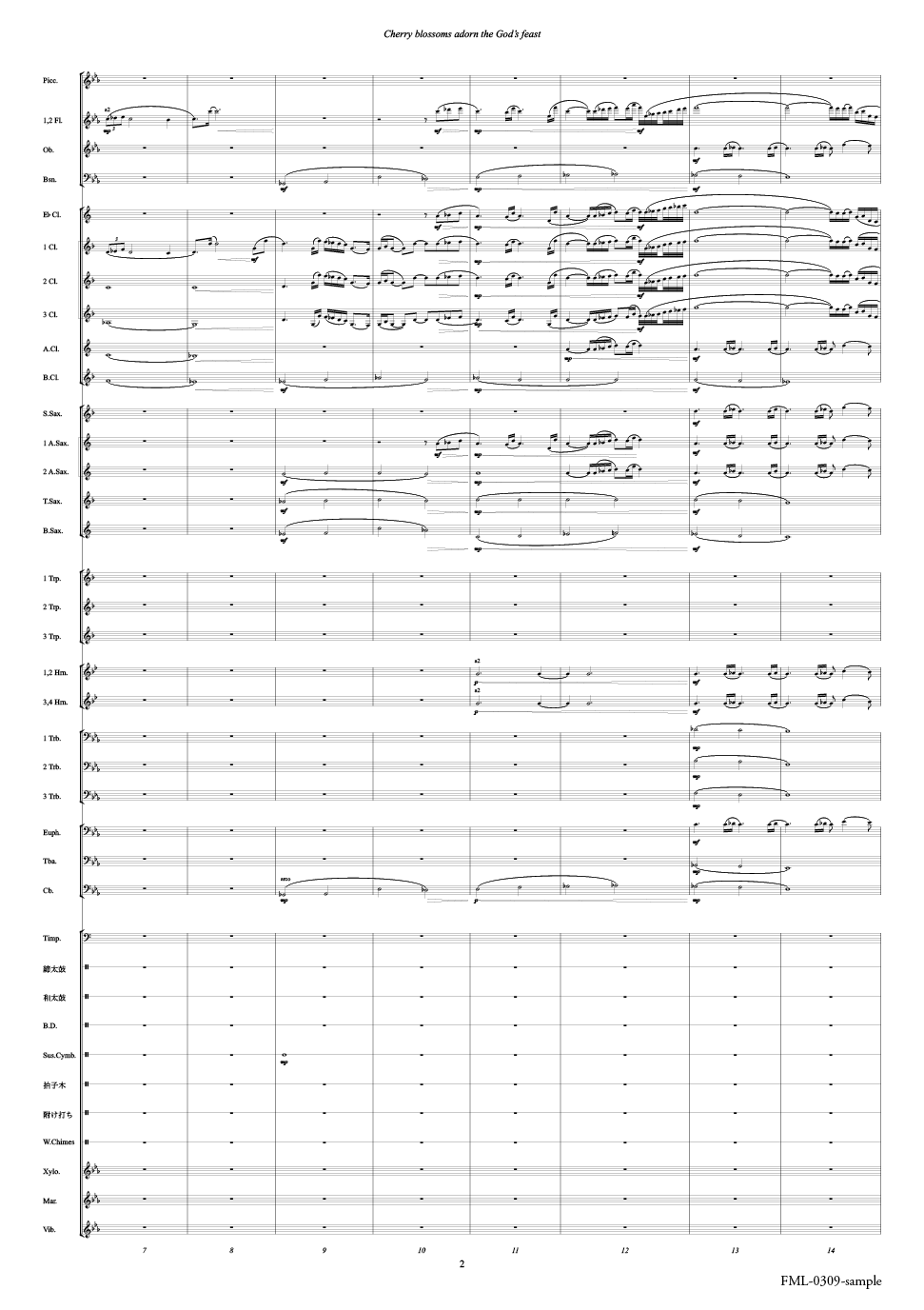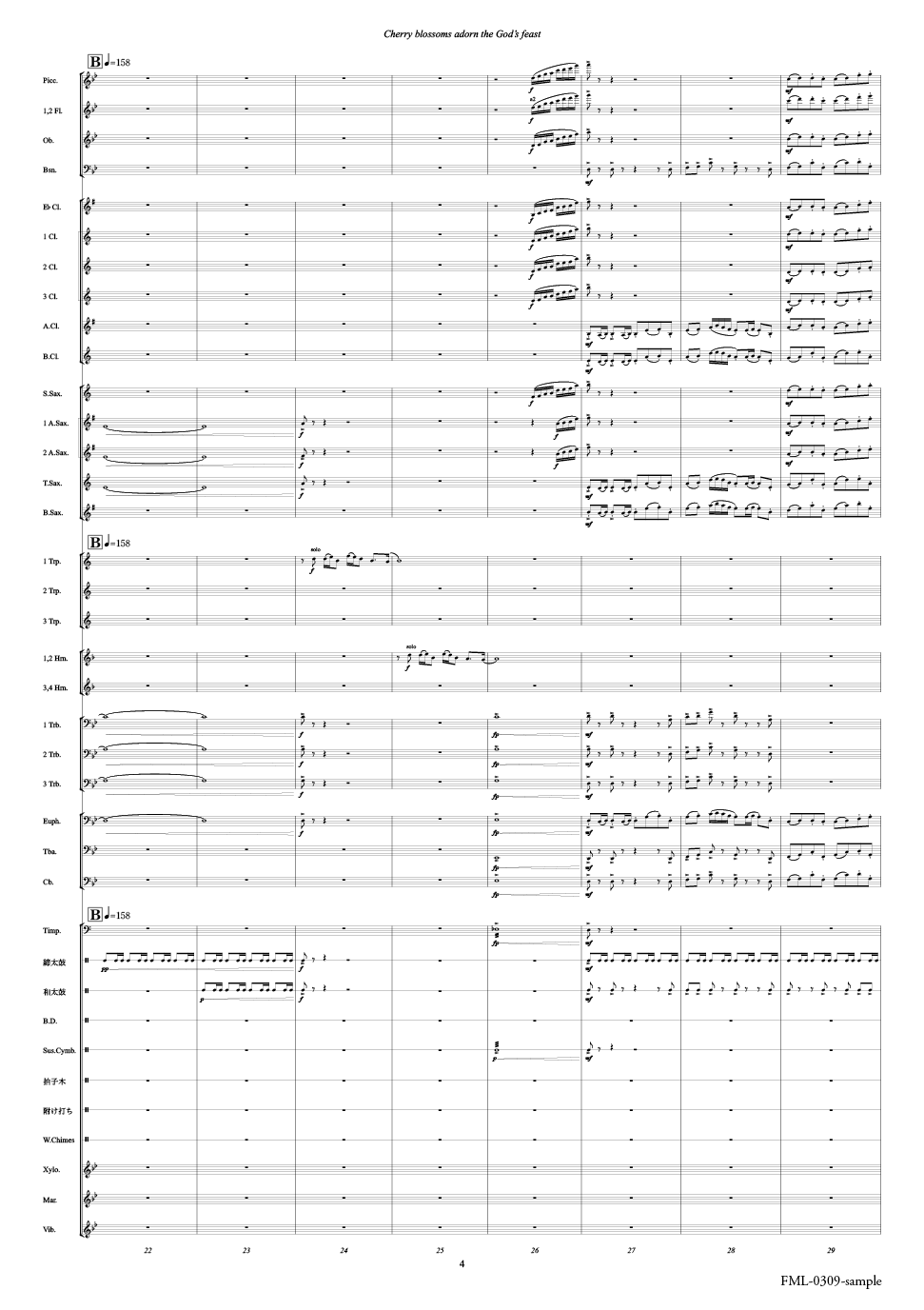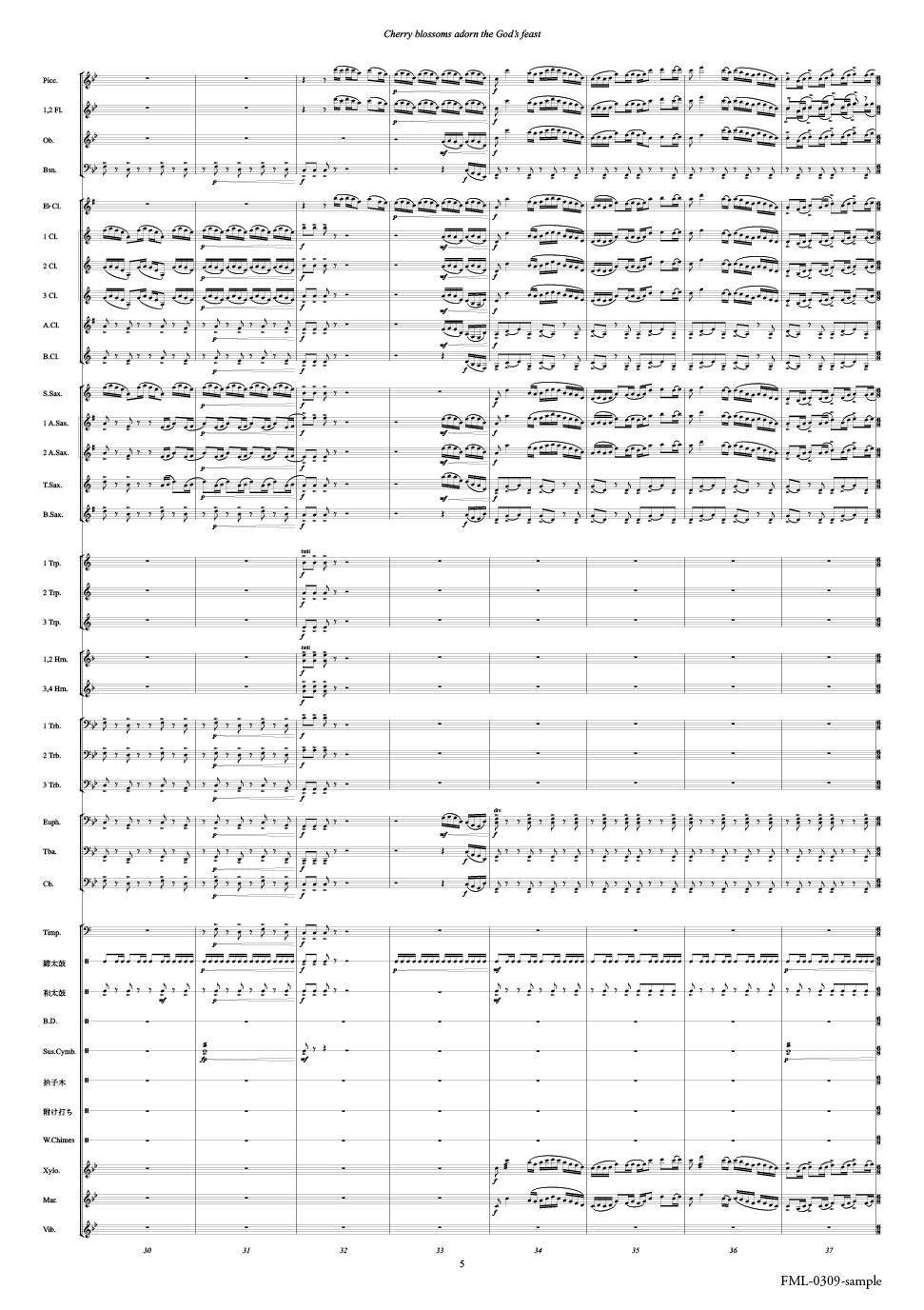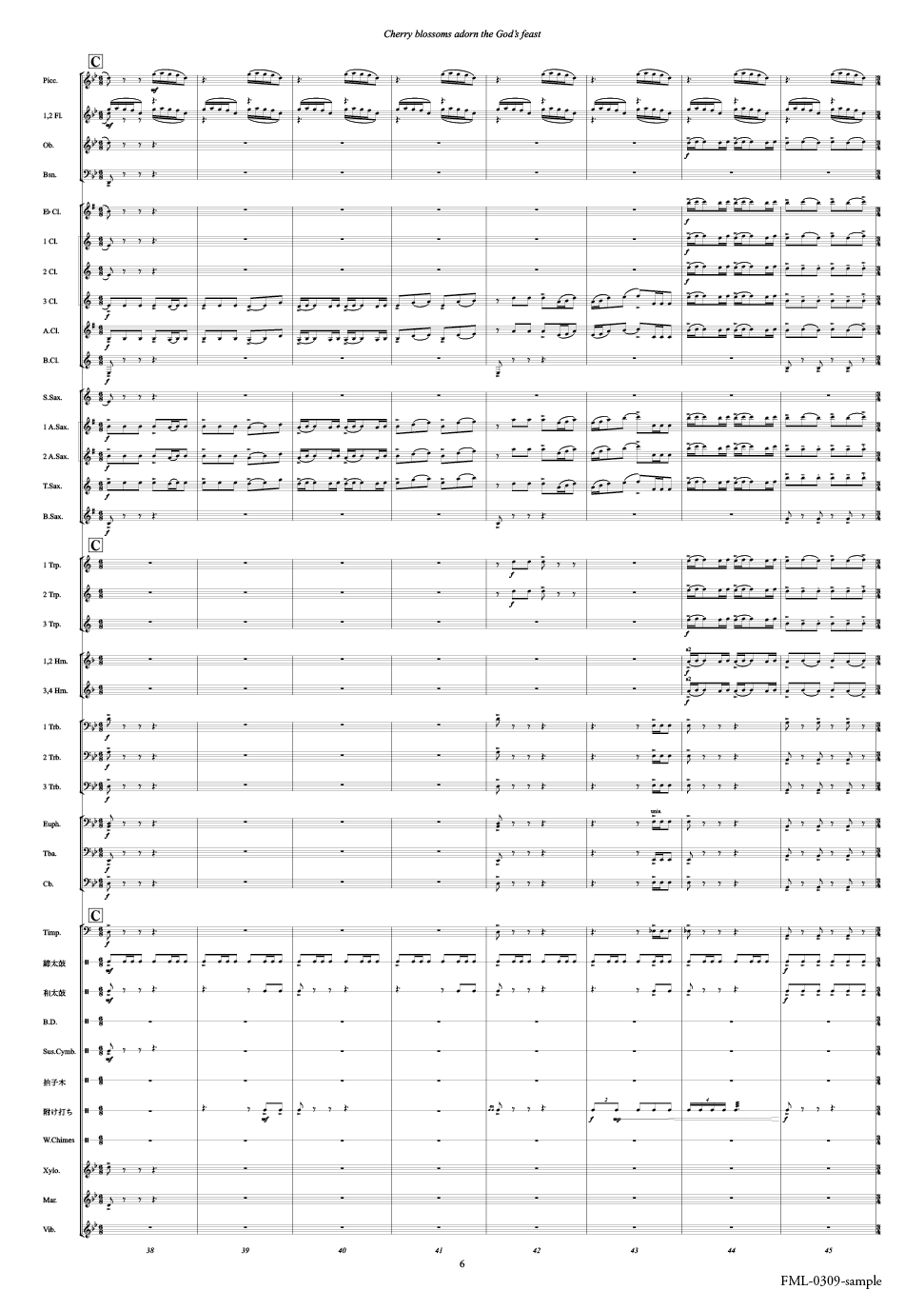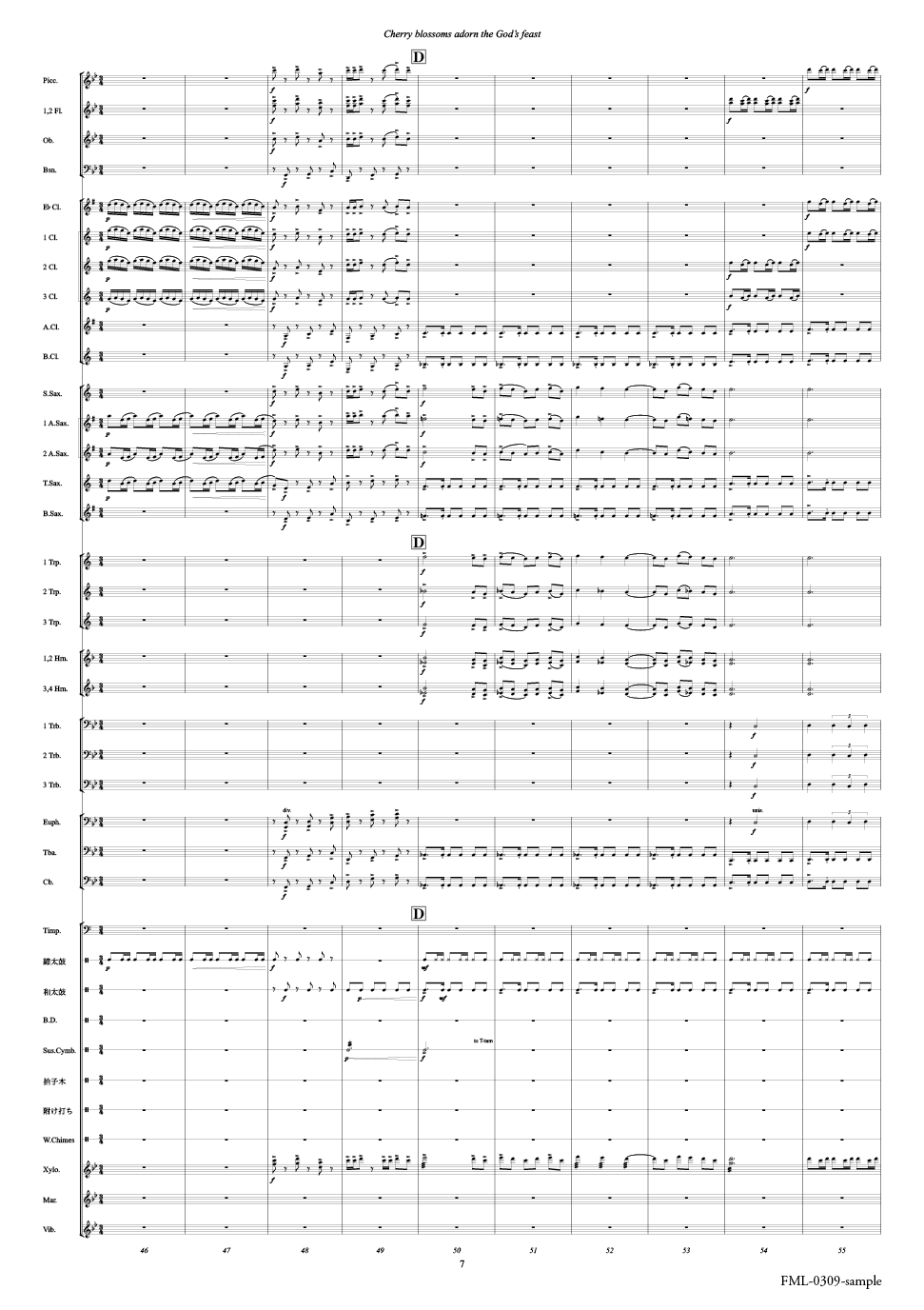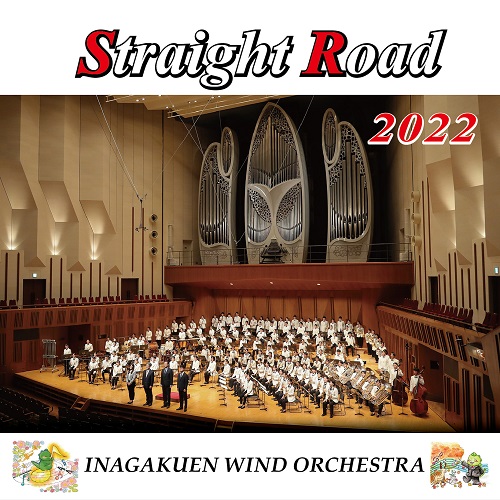12月25日15時を持ちまして、
2025年内出荷の注文受付を終了いたしました。
以降のご注文は年明け
【 2026年1月7日(水)以降順次出荷 】
となります。予めご了承ください。
本年もたくさんのご愛顧を賜りありがとうございました。
よいお年をお迎えください。
神宴の櫻:樽屋雅徳 [吹奏楽スコア]
・1配送につき税込11,000円以上のご注文で国内送料無料
・コンビニ後払い、クレジットカード、銀行振込利用可
・[在庫あり]は営業日正午までのご注文で即日出荷
・International Shipping
- 作曲: 樽屋雅徳
- 編成:45パート
- 演奏時間:0:07:30
- グレード:4+
- スタディスコア(演奏・編曲利用不可)
フォスターミュージック/FML-0309FS
- 概要
- 編成/曲目
- 補足
- ENGLISH
神宴の櫻
精華女子高等学校吹奏楽部の櫻内教昭先生とフォスターミュージックの委嘱で作曲させていただきました。
作曲の題材を探しに顧問の櫻内先生と出雲の旅をさせていただいた中で「万九千神社」の神在月のお話が印象に残り、それを曲にしようと思いました。
旧暦10月は全国の八百万(やおよろず)の神々が出雲の国に集まる月。他の土地では神様が留守になるので神無月といいますが、出雲では神在月と呼びます。
神々が集う出雲の各神社では「神迎祭(かみむかえさい)」に始まり、「神在祭(かみありさい)」そして、全国に神々をお見送りする「神等去出祭(からさでさい)」が行われます。
曲は冒頭、神迎えにあたる龍神祭(りゅうじんさい)を、宮司一人が、神社近くの斐伊川の水辺で秘儀として行う様子を表現しています。
やがて木管楽器群のアンサンブルに進み、「祈り」のメロディを奏でます。
そのままアレグロ部分に進み、木管群の細かいパッセージや、太鼓のリズム、金管の勇ましいメロディが、龍蛇が空を舞い神々を導き現れる様を表現します。
曲は再び穏やかになり、やがて全体へと受け継がれた神々のメロディが威厳を表現したのち、エンディングに向け華やかな部分へと進みます。
神々は当地において直会(なおらい)と呼ぶ酒宴を催し、明年の再会を期して、翌朝早くいよいよ各地の神社へと帰途につかれるそうです。
神が集まれば桜も咲かせ華々しい宴を繰り広げます。
そんな神宴を表現し、曲は華々しく幕を閉じます。
曲名の「櫻」は、委嘱者である櫻内先生の旧字体を使わせていただきました。(樽屋雅徳)
仕様
- アーティスト
- 作曲: 樽屋雅徳
- 演奏形態
- 吹奏楽
- 編成
- 大編成 / 45パート
- 演奏時間
- 0:07:30
- グレード
- 4+
- 商品カテゴリ
- スコア
- 出版社 / 品番
- フォスターミュージック / FML-0309FS
- JANコード
- 4560318478176
- 発売日(年)
- 2022/04/14
- 【レンタル譜】神宴の櫻:樽屋雅徳 [吹奏楽大編成]
スタディスコア/セット・版違いなど
楽器編成
- Piccolo
- Flute 1
- Flute 2
- Oboe
- Bassoon
- Eb Clarinet
- Bb Clarinet 1
- Bb Clarinet 2
- Bb Clarinet 3 (div.)
- Alto Clarinet
- Bass Clarinet
- Soprano Saxophone
- Alto Saxophone 1
- Alto Saxophone 2
- Tenor Saxophone
- Baritone Saxophone
- Trumpet 1
- Trumpet 2
- Trumpet 3 (div.)
- Horn 1
- Horn 2
- Horn 3
- Horn 4
- Trombone 1
- Trombone 2
- Trombone 3
- Euphonium (div.)
- Tuba (div.)
- String Bass (div.)
- Timpani
- Percussion 1 (締太鼓)
- Percussion 2 (和太鼓)
- Percussion 3 (Bass Drum)
- Percussion 4 (Suspended Cymbal, Tam-tam)
- Percussion 5 (拍子木, Cymbals, Tam-tam)
- Percussion 6 (附け打ち)
- Percussion 7 (Wind Chimes, 拍子木)
- Xylophone
- Marimba, Glockenspiel
- Vibraphone
樽屋雅徳(Masanori Taruya)
1978年千葉県銚子市生まれ。武蔵野音楽大学音楽学部作曲学科卒業。佐藤博、宮本良樹各氏に師事。
フランスで吹奏楽曲「Ardent Overture」を出版。代表作として「絵のない絵本」「民衆を導く自由の女神」「マゼランの未知なる大陸への挑戦」「ラザロの復活」「マードックからの最後の手紙」などがある。
全国の吹奏楽団やマーチングバンドからの委嘱も数多く、その作品の多くが国内外問わず広く演奏され、日本でもっとも人気のある作曲家のひとりである。また、作曲・編曲の傍ら、吹奏楽指導やコンクール等の審査員、執筆活動などでも多くの成果を挙げている。
2004年 2018年まで銚子市立銚子高等学校の音楽監督を務めマーチングコンテストで全国大会へ、吹奏楽コンクールでは東関東大会、東日本大会へと導く。
現在はベルモンテウィンドオーケストラの指揮者・音楽監督を務め、指導者としても高い評価を受けている。
- サイズ
- A4/1cm未満
CHERRY BLOSSOMS ADORN THE GOD'S FEAST:Composer: Masanori TARUYA
This piece was jointly commissioned by Mr. Noriaki Sakurauchi from Seika Girls’ High School Band and fostermusic Inc.
When I visited Izumo with my advisor Mr. Sakurauchi in search of inspiration for the composition, I was struck by the Mankusen Shrine’s memorable tale of Kamiarizuki, which I decided to draw on for this piece.
The 10th month of the lunar calendar is usually known as Kaminazuki in most places in Japan as the divinities are believed to be away during this time, but it is known as Kamiarizuki in Izumo because that is the place where the countless divinities of Japan gather in this month.
A Kamimukaesai is held at each shrine in Izumo where the divinities gather to welcome them, followed by a Kamiarisai, and finally a Karasadesai to see them off as they return to the rest of the country.
The piece opens with a depiction of the Ryujinsai, a secret ceremony to welcome the divinities that is held by the chief priest alone by the waterside of the Hii River near the shrine.
The woodwind ensemble gradually takes over, leading up to a melody reminiscent of prayers.
The piece then enters an Allegro section, where the delicate passages of the woodwind instruments, the rhythm of the taiko drums, and the heroic melody of the brass instruments combine to conjure a scene of dragons and serpents soaring through the sky and leading the divinities.
The music then calms down again before the melody of the divinities that now permeates the entire orchestra pays tribute to their grandeur and culminates in a dazzling ending.
The divinities hold a feast called Naorai at the site before finally returning to their respective shrines early the next morning, promising to meet again the following year.
The gathering of the divinities sparks the blooming of cherry blossoms as their magnificent feast unfolds.
The piece marks this feast of gods by ending with a flourish.
This piece is entitled “Sakura,” with the old form of this Japanese kanji character taken from the name of Mr. Sakurauchi, who had commissioned it.
Specifications
- ARTIST
- Composer: Masanori TARUYA
- INSTRUMENTATION
- Windband / More than 36 Players
- DURATION
- 0:07:30
- GRADE
- 4+
- PRODUCT TYPE
- STUDY SCORE (PARTS Sold separately)
- PUBLISHER / Code
- fostermusic Inc. / FML-0309FS
- JAN
- 4560318478176
- RELEASE
- 2022/04/14
- OVERSEAS SHIPMENT
- Ask
- EUROPEAN PARTS
- Not Included
For foreign customers,
You can now purchase from overseas via WorldShopping BIZ.
Study scores, ensembles, and CDs can be ordered directly from our website.
Rental sheet music and some other items are not covered by this cart system, so please contact us by email.

![神宴の櫻:樽屋雅徳 [吹奏楽スコア]](/html/upload/save_image/FML0309_3.png)
